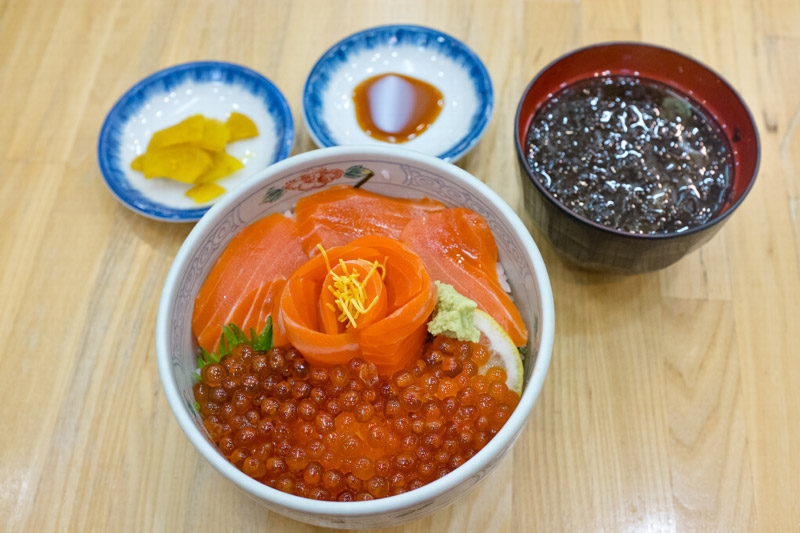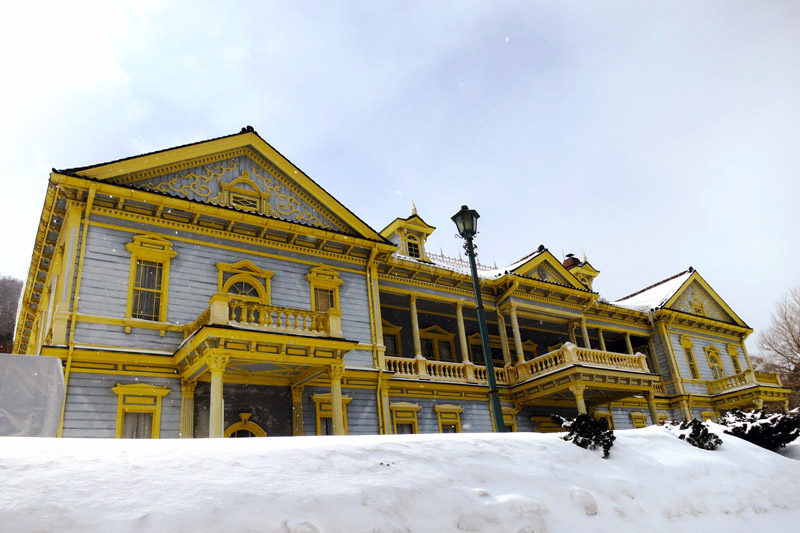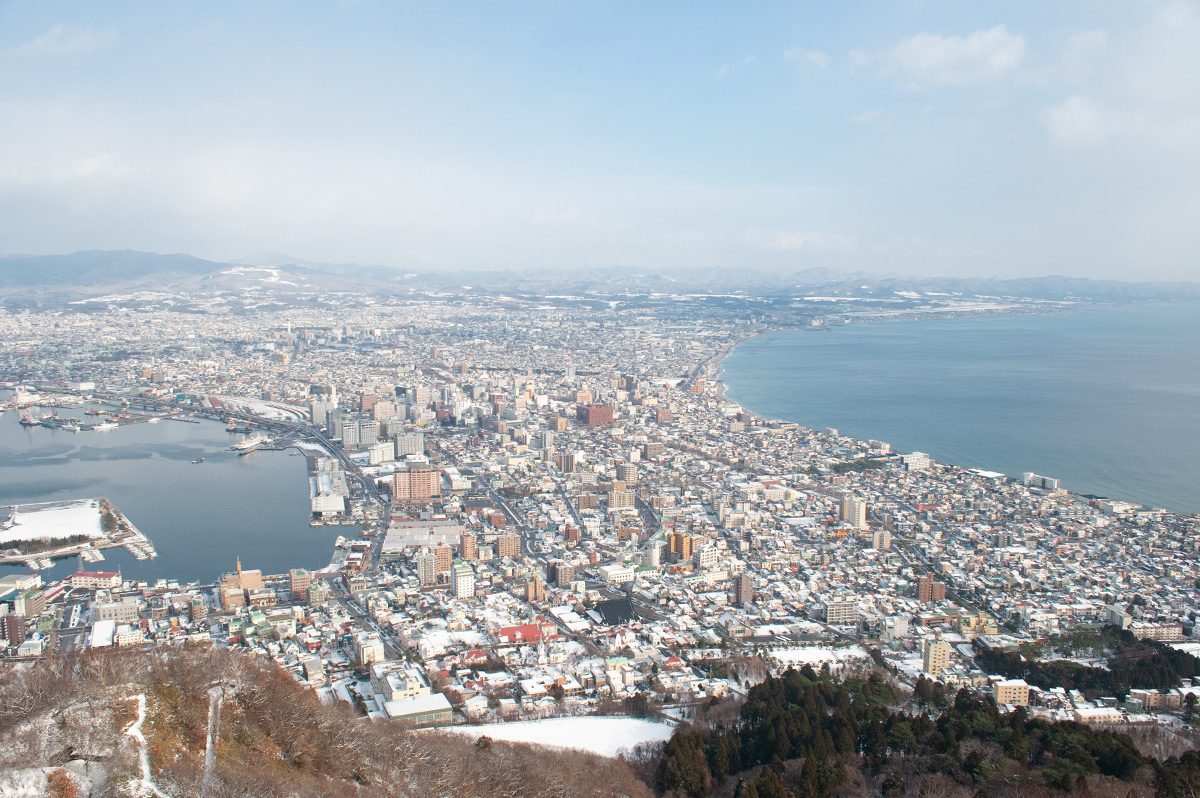Home / Destinations / Japan / A Hakodate Itinerary – The Best Things to Do in Hakodate

By James Davies in Japan Guides.
Hakodate is a fascinating port city which has plenty to explore. A combination of incredible scenery, mouth-watering food, colourful pretty streets and a historic harbour means there are plenty of things to do in Hakodate to keep you busy.
If you have a day or two to spend, everything you need to see and do is in our Hakodate itinerary.
Yes, Hakodate is absolutely worth visiting.
Located on the southern tip of Hokkaido, Hakodate is one of the most unique cities in Japan, thanks to it’s fascinating and cosmopolitan history.
One of the first cities in Japan to open up to overseas trade, Hakodate features many historic Western-inspired buildings that still line the city’s streets.
The city’s former harbour is now home to an array of shops, restaurants and more, and you’ll find some of the best seafood in Japan in the Hakodate Morning Market. To top it all off, the view of the city from the top of Mount Hakodate are out of this world.
There are plenty of things to do in Hakodate to warrant staying for at least two or three days.
If you need somewhere to stay then there are a number of excellent hotels in Hakodate, especially around Hakodate JR Station.
• The Four Points by Sheraton, the Comfort Hotel Hakodate and the Hotel Resol Hakodate are all excellent three star hotels just a few minutes’s walk from Hakodate Station.
• If you’d prefer to be closer to Hakodate’s historic Motomachi area, we can recommend La Jolie Motomachi, where we stayed. Rooms are large and extremely comfortable and there’s an excellent breakfast spread each morning.
Just three tram stops from Hakodate JR station, La Jolie Motomachi is within walking distance of Motomachi’s main sights as well as the Mount Hakodate Ropeway.
→ You can search for the best prices on hotels in Hakodate on Booking.com here.
From the main sights, the best places to shop and the must-eat food, here are the best things to do in Hakodate.
There’s no better place to begin your Hakodate itinerary than at the Hakodate Morning Market.
Directly opposite Hakodate station, the stalls inside Hakodate Morning Market are piled high with a mind-boggling array of fresh and dried seafood, including crab, tuna, salmon and scallops.



Fresh seafood on sale at Hakodate Morning Market
You can even try your hand at fishing for your lunch from tanks filled with freshly caught squid. Pick up a rod and if you manage to hook a squid one of the market’s sushi chefs will make squid sashimi for you.
Besides seafood there’s also a wide range of fresh fruit and veg, including delicious slices of melon, another speciality of Hokkaido.
Just next door to the main thrust of Hakodate Morning Market, Donburi Yokocho is the perfect place for breakfast.
Around twenty donburi restaurants are crammed into a narrow arcade, each one with a window display filled with plastic models of the dishes on their menu.

Each restaurant specialises in donburi dishes topped with a huge choice of fresh seafood, all caught in the seas around Hakodate.
As well as salmon and tuna there are several other donburi dishes available, such as shrimp, scallop, squid, sea urchin, crab and salmon roe.
Click here for a list of Donburi Yokocho’s restaurants and their specialities.
A little further along Hakodate’s waterfront are the Kanemori Red Brick Warehouses.
Once used for storage during Hakodate’s days as a bustling port, several gorgeous old warehouses have now been converted to host a number of excellent shops, cafes and restaurants.

The shops inside Kanemori sell a variety of local speciality souvenirs, confectionery and foods as well as clothing and jewellery. There are also several cosy cafes that specialise in Japanese and Western foods.
For a real feast don’t miss the vast and hugely atmospheric Hakodate Beer Hall. Here you can find great food along with fantastic locally brewed beers.
When Japan ended its policy of isolation in 1854 Hakodate was one of the first port cities to open up to foreign visitors.
The early Western influence on Hakodate can still be seen today. Many beautiful and historic Western-inspired buildings still remain throughout the city.

The majority of these can be found in the neighbourhood of Motomachi. Motomachi’s picturesque streets resemble a film set, lined with grand colourful public buildings, pretty churches and former Consulates.
Next to Motomachi Park is the spectacular Old Public Hall of Hakodate and the Hakodate Branch Office of Hokkaido Government building, which is now an information centre.

Nearby stands the Former British Consulate of Hakodate. Inside is an excellent exhibition documenting the history of the consulate and the opening of Hakodate to foreign ships.
The former consulate also has a superb café on the ground floor where you can take typically British high tea.
A few streets away is the famous Hachiman Zaka Slope. The top end of this sloping street offers incredible views across Hakodate Bay.


The Orthodox Church and Hachiman Zaka Slope in Hakodate’s Motomachi at night
Just around the corner are three striking white churches, all built in completely different architectural styles.
The Russian-inspired Hakodate Orthodox Church, the classically European Motomachi Catholic Church and the retro-modern Anglican St John’s Church could all make you think you were somewhere other than Japan.
No Hakodate itinerary is complete without a trip to the summit of Mount Hakodate.
At 334 metres above sea level, the views from Mount Hakodate are breathtaking, especially on a clear night when the entire city is illuminated by light.

The Mount Hakodate Ropeway whisks passengers from Motomachi to the summit of Mount Hakodate in just 3 minutes.
The stunning panoramic view shows the two wide bays that frame Hakodate, with all of the city’s landmarks easy to spot. Be sure to pick a clear day when heading to the peak – when the clouds gather the view of the city disappears.
In the far west of Hakodate is Hakodate Foreign Cemetery where a number of the early overseas settlers are buried.
The Foreign Cemetery dates as far back as the 1850s, when two American sailors were first buried here.


A gravestone at the Foreigner’s Cemetery in Hakodate and the entrance gates to the Chinese graveyard
In the following years many other foreign sailors and diplomats were also buried in the graveyard.
Graves are grouped together by nationality, with separate sections dedicated to those from America, Russia, China, and Europe. Hugging a stretch of the coastline, all graves face out onto the sea.
Another reason to venture this far west is for Cafeteria Morie at the far end of the Foreign Cemetery. There is a strong Russian influence in Hakodate, as seen in the Hakodate Orthodox Church and the nearby former Russian Consulate.

With wonderful views overlooking the sea, the cosy Cafeteria Morie has a Russian inspired menu, including delicious baked pirozhki served with traditional Russian black tea with jam.
At the southernmost tip of Hakodate is Cape Tachimachi.
Cape Tachimachi is a gorgeous stretch of rocky coastline, with wide open views of the Tsugaru Straights as well as a glorious panorama back towards Hakodate.

Sat beneath the peak of Mount Hakodate, Cape Tachimachi is a wonderfully peaceful spot to relax. On a clear day you might even be able to see across to Honshu, the main island of Japan.
In the north of Hakodate is Goryokaku, a star-shaped park framed by a moat that dates from the late Edo Period.
Goryokaku was built as a military fort to protect Hakodate from possible invasion. In the early 20th century the fort was transformed into a public park. In the centre of Goryokaku Park is a modern replica of the Former Magistrate Office.


Today, Goryokaku is particularly popular during cherry blossom season. Over a thousand cherry blossom trees line the park’s moat which usually come into bloom in late April and early May each year.
The best view of Goryokaku can be seen from Goryokaku Tower which stands directly opposite the park. Besides the fort, Goryokaku Tower also offers fantastic views across the whole city and towards Mount Hakodate.
If you have the time, a trip to Lake Onuma is definitely worth adding to your Hakodate itinerary.
Only thirty minutes by train from Hakodate, Lake Onuma is a beautiful quasi national park. Walking paths cross a series of islands that dot the tranquil lake that sits beneath the triangle-tipped Mount Komagatake.

In summer there are boat trips out onto the lakes, and in autumn the park is filled with colour. During Hokkaido’s long winter the park is covered in a thick layer of snow.
As well as the walking paths around Lake Onuma, don’t miss the more secluded scenic walks around the smaller Lake Konuma. The entrance to Lake Konuma is just a few minutes’ walk north of Onuma-koen station.
One of the best things to do in Hakodate is eat, and Lucky Pierrot Burger is one of the best and most unique restaurants in Japan. No Hakodate itinerary is complete without a visit to at least one branch of Lucky Pierrot Burger.
Lucky Pierrot Burger is a chain restaurant with a difference. There are 17 branches of Lucky Pierrot Burger, all located in Hakodate, though no two restaurants are the same.

Each branch of Lucky Pierrot Burger has its own theme complete with a wonderfully weird interior.
One branch is dedicated to Elvis Presley whilst another is filled with everything to do with Audrey Hepburn. The branch opposite Goryokaku Tower is angel themed, and in the branch in Jujigai it is Christmas all year round.
Though this might all sound like a cheap gimmick, the food at Lucky Pierrot Burger is the main reason to visit.
Of the wide range of mouth-watering burgers on the menu the succulent Chinese chicken burger is the chain’s best seller. Pair it up with a mug of fries drizzled with gravy and cheese sauce.


A giant model of the Chinese chicken burger in Lucky Pierrot Burger in Hakodate’s bay area and the chain’s logo on a can
There’s much more on offer than just burgers, too. Lucky Pierrot Burger’s menu also has a wide selection of delicious curries and omurice dishes.
Prices are cheap (most burgers are around ¥400) and the portion sizes are huge, making a visit to at least one branch of Lucky Pierrot Burger an essential addition to any Hakodate itinerary.
Many of Hakodate’s main sights are within walking distance of each other, but there are times when you’ll need to use public transport to get around the city.
There are two tram lines in Hakodate that connect Motomachi and the main bay area with the rest of the city.
Both trams follow much of the same route and separate at Jujigai; route 2 then heads south towards Cape Tachimachi, whilst route 5 continues north towards the Foreigner’s Cemetery.
IC cards from any of Japan’s major cities, such as Pasmo, Suica or Icoca, can be used on Hakodate’s trams.
If you don’t have an IC card, then take a ticket from the ticket machine next to the door when you board. Drop the ticket and the correct fare into the machine next to the driver when you’re ready to disembark.
If you’ve liked this post please share it on the socials:
Follow our travels on Instagram here, and keep up to date with our latest posts on Facebook here.

I’m James, the founder, editor, writer and photographer at Where You’re Between. Currently based in Japan, I started Where You’re Between in 2017 to create detailed itineraries and in-depth travel guides for the places that I’m fortunate enough to visit. You can see all of our destinations here.
• Why winter is the best time to visit Sapporo
• Discover Noboribetsu, Hokkaido’s Hell Valley
• What to see in a day trip to Otaru
• How to spend two days in Tokyo
• When is the best time to visit Tokyo?
• Top tips and travel advice for your first trip to Tokyo
• How to watch a sumo training session in Tokyo
• These are the best day trips from Kyoto
• How to spend 24 hours in Osaka
• What to see on a day trip to Nara
• 35 destinations to explore off the beaten path in Japan
• The perfect two days on Naoshima, Japan’s art island
• Why Koyasan is the most sacred town in Japan
• The complete guide to hiking in Kamikochi
Please note that this post contains some affiliate links. If you click these links and go on to make a purchase we will earn a small commission at no extra cost to you.
© WhereYoureBetween.com – 2024
Cookies help us deliver our services – by continuing to browse this site, you agree to our use of cookies.
There's a World Out There. Let's Go!
Sign up to our email newsletter for a monthly(ish) dose of wanderlust